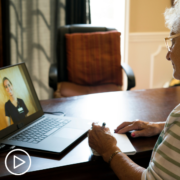What Are the Goals of CLL Treatment?
What Are the Goals of CLL Treatment? from Patient Empowerment Network on Vimeo.
What are some of the goals of chronic lymphocytic leukemia (CLL) treatment? Dr. Matthew Davids outlines some different treatment goals and how the goals are impacted by a patient’s age and other considerations.
Dr. Matthew Davids is Director of Clinical Research in the Division of Lymphoma at Dana-Farber Cancer Institute. Learn more about Dr. Davids here.
Related Resources:

|
Transcript:
Katherine:
With CLL, what are the goals of treatment?
Dr. Davids:
I like to say to patients, “The goals are to make you live longer and live better.” You want to obviously have treatments that prolong life, but you also want to have treatments that are helping with symptoms, and giving patients more energy, and making them feel better, and protecting them from some of the risks of the disease. And so, I think the goals do vary a bit based on the stage of life that patients are at.
I see a lot of patients in their 70s and 80s, and in those patient’s symptom control, having the disease be in a good remission, allowing them to live their life is a good goal. I sometimes see patients in their 40s and 50s, and some of those patients want to be a bit more aggressive and try to do a strategy that will get them a very long-term remission, and even potentially explore potentially curative strategies.
If I have a higher-risk patient with deletion 17p who’s young and fit, and they’ve already had some of the novel treatments, that’s where we start thinking about clinical trials of some of the cellular therapies like CAR-T cells that people may have heard of where you use the T cells from the patient to try to use that as a therapy to kill off the disease. Or even a bone marrow transplant is something that we have used historically in CLL. We don’t use it as often now, but for younger patients with high-risk disease it’s still a consideration to try to achieve a cure of the CLL even though the risks of that are significant.












